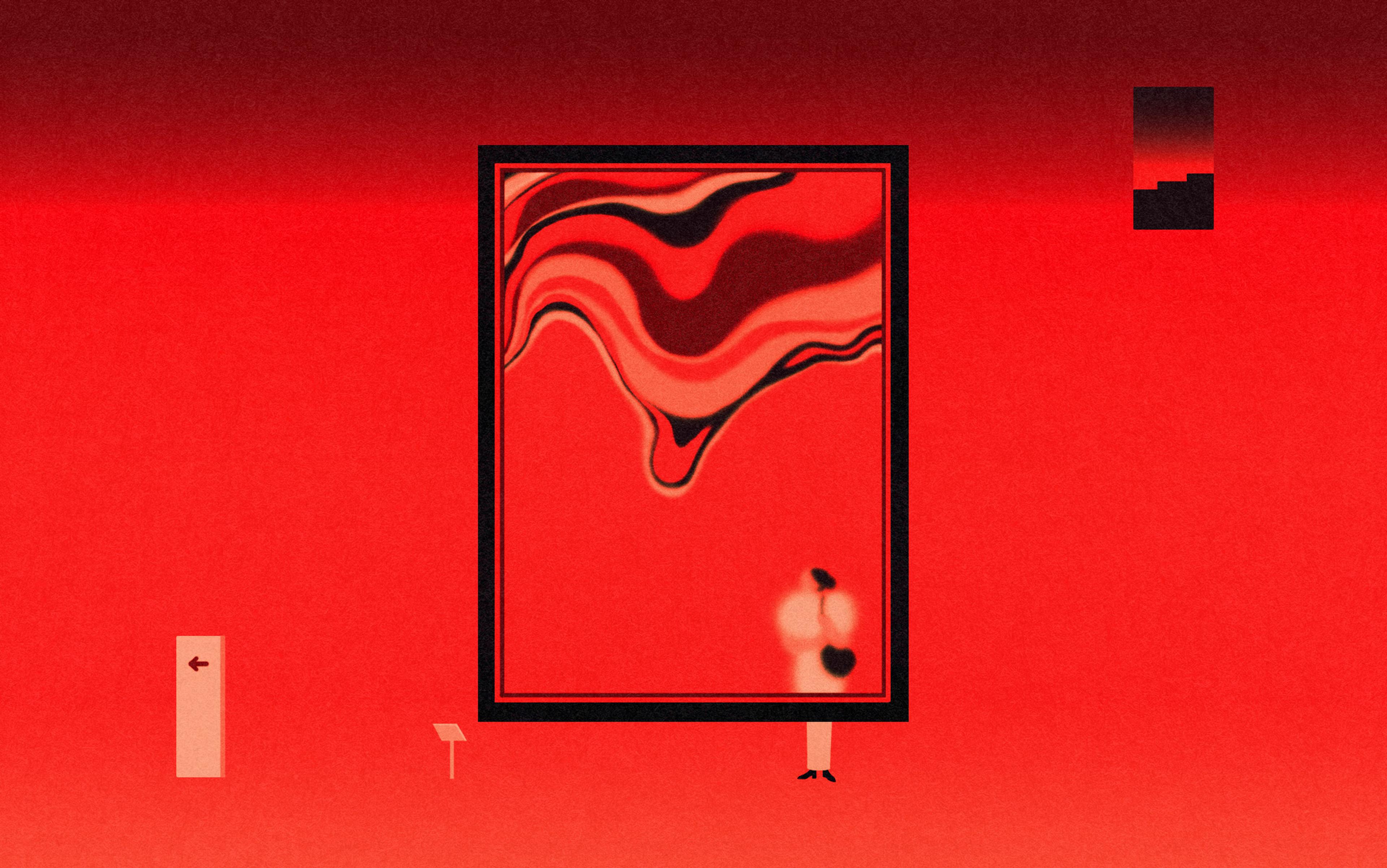The everyday experience of irritation conceals a paradox. When one is suitably attuned, virtually anything is liable to provoke it: a telephone left to ring or a phone call taken, people who walk too slowly or drive too quickly. Running late is irritating but so is arriving early. Impudence is irritating but obsequiousness even more so. Yet, however various its incitements, irritation is also an empty and tautological feeling. The irate know their claims against the world to be baseless or at least wildly exaggerated, and this, too, annoys them. Seemingly about every little thing and also nothing at all, irritation is a feeling in search of causes: it goes out into the world, and finds them.
On a recent train journey, my irritation flared by degrees. There were no tables or plugs, so I couldn’t work. The chair was uncomfortable, my back sore, and the loudspeaker kept sounding directly overhead. I sighed and shifted in my seat, feeling my partner grow irritated by me, and this seemed to relieve me of the feeling. Moving closer, I tried to comfort her; at which point she got up to fetch her water bottle, took a few performative sips, and settled into the chair opposite. I found the dishonesty of this gesture grating and, as the train crawled towards our destination, irritation passed between us like a ball, both of us insisting that nothing at all was the matter.
Something about this ordinary, negligible feeling seems to make it inaccessible to critical reflection. Perhaps because, when irritable, we tend to be at our least reflective – preoccupied with those diminutive miseries whose oversize effect we know would not stand up to criticism. It is as though irritation always suspects itself to be ridiculous, and must avoid looking at itself too closely lest it be annoyed by its own speciousness.
For Aristotle, irritation was closely related to anger. You might say that irritation is anger’s meaner little sibling – what, in Ugly Feelings (2007), the scholar Sianne Ngai calls ‘inadequate’ anger. One loses oneself in a rage – that is one of anger’s seductions: it offers a holiday from the self, that licenses acts ordinarily proscribed. To be irritated is to hover at anger’s threshold, while knowing its repertoire of decisive actions are inappropriate responses to the present situation. Communicated by huffs and sighs but rarely through more drastic measures, irritation is a feeling that’s expressed only through being inadequately expressed. One is not moved to commit appalling acts due to irritation. Nor is one permitted to do so: there are no ‘crimes of irritation’, no clemency for the irate.
In his Life of Samuel Johnson (1791), James Boswell tells us of the ‘perpetual irritation’ that made his friend’s ‘existence misery’. Indeed, there seems to be nothing one can do with one’s irritation; and the usual solutions – breathe, count to 10, relax – have the unfortunate quality of being themselves very irritating. It is this ongoing and helpless quality that makes irritation so frustrating. Unlike irritation, however, frustration enjoys the advantage of existing in dialectical relation to satisfaction. Really, it is a promissory note against a future satisfaction, one whose pleasure increases, like interest, in proportion to its postponement. Irritation, meanwhile, does not make us any nice promises: once irritated, one hopes only for its abatement.
And yet, however much we dislike it, we are very resourceful in our search of pique. Nor need we look far to find it: partial to the mundane, irritation is often a household feeling. In Maeve Brennan’s story ‘Family Walls’ (1973), a marriage rocks unsteadily when Hubert Derdon is baffled to see his wife, Rose, close the kitchen door the very moment he returns home. He decides to confront her, writes Brennan, but ‘at the kitchen door he hesitated’, and soon the pique generated by this non-event morphs into a catalogue of all the ways that, over the years, she has ‘irritated him nearly beyond endurance’. Once we have entered a state of irritation, we are often afflicted by one thing after another – as if via all the accumulating annoyances we might cross the threshold that will stir us, finally, into action.
But for the most part we continue to endure it. Franz Kafka notes how at dinnertimes his father’s irritation would ‘settle on [a] matter as a pretext for breaking out’, and his only recourse when faced with these trifling yet voluble complaints was to ‘escape … within [his] own self.’ It is true that when we are irritable we do not make it easy for those around us. Even when it’s directed at others, irritation is generally an antisocial feeling, a conversation with oneself. This is probably because irritation’s gripes tend to be so superficial as to be virtually incommunicable: one is irritated by how a person speaks, their tone or timbre, rather than by what is actually said. While anger burns and sadness wounds, irritation’s lesions are skin deep. How could anyone be expected to take them seriously?
In modern English, ‘irritation’ refers to both mental and physical discomfort, and both meanings, according to the Oxford English Dictionary, have been in use since the early modern period, when the word was absorbed, via French, from Latin. In the physical sense, we tend to be irritated by what abrades, chafes, scratches, catches, tickles, prickles or rubs. Bodily irritation is associated with the surfaces where outside meets in – skin, eyes, genitals, airways; and with those nooks and creases (armpits, groin, backs of knees) where our bodies fold in upon and touch themselves.
Most irritating of all is itch, an affliction endemic to our largest and outermost organ. If, as according to folk biology, the purpose of pain is to send the mind a clear message (‘Stop!’), then itching seems to express a more indeterminate state of unease. Itching is an incitement, asking to be cancelled out by the act of scratching. And yet the relief offered by scratching is of a very ambiguous sort.
It is always like that with irritation: we love how hateful it lets us feel
As the scholar Steven Connor points out in The Book of Skin (2003), scratching – which involves scraping off layers of skin, typically with one’s fingernails – is really a (satisfying) form of irritation. Hence dermatologists speak of the ‘itch-scratch cycle’, in which we find coursing across the epidermis the full spectrum of irritation’s fluctuating potentials for pain and pleasure; the ambiguous but not completely unpleasant way that irritation keeps us returning to the source of our discomfort. (Advertisers have long sought to capitalise on this ambivalence: hence, the jingle.)
When I told people I was writing about irritation, they generally responded by telling me about their irritating experiences – which soon began to grate. One friend informed me about the insufferable conversation he’d overheard at a bar the night before. I asked if he moved; however, he appeared not to hear the question as he proceeded to relate, with Boswellian recall, every detail of that conversation. Normally so polite, he was unsparing in his delighted excoriation of the basically harmless couple. It is always like that with irritation: we love how hateful it lets us feel, perhaps because – unlike anger – we don’t take it too seriously.
It surely reflects the fugitive pleasures of irritation that there are so many wonderful, chewy words to describe those who are irritable: prickly, testy, cantankerous, crotchety, disputatious, grumbling, peevish, plaintive, irascible, and ornery. Yet, in a culture that equates depth with significance, we tend to be quick to dismiss our irritation (‘It was nothing’). Perhaps this is why, compared with more culturally prestigious moods such as anger, despair, joy, dread or melancholia, irritation has received little attention. In Barbara H Rosenwein’s book Anger: The Conflicted History of an Emotion (2020), ‘rage’ receives dozens of mentions; irritation, one. Friedrich Nietzsche was disparaging about the tendency to keep our eyes trained exclusively on the depths, blinding us to the variety shimmering at ‘the surface … and the skin’, and in The Gay Science (1882) the irascible philosopher celebrates those who are superficial ‘out of profundity’.
By attending to the profundity of this superficial feeling, might we open our eyes to what is hiding in plain sight?
In the small philosophical literature on irritation, there are two prevailing views: those that see it as a form of anger, and those that see it as a form of sensitivity. In the Nicomachean Ethics, Aristotle offers the following character sketch: ‘The people we call irritable are those who are irritated by the wrong things, more severely and for longer than is right.’ As with elsewhere in this work, Aristotle is attempting to define the most balanced, and therefore most virtuous, distribution of affect. He places irritation on the side of excess: too much, for too long.
And yet, as a vice, irritation is also a form of deficiency. Compared with anger, irritation seems sorely lacking – in conviction, justification, solutions. Writing in the 3rd century CE, the early Church father Tertullian draws attention to this ambiguity when he suggests that irritation is a corrupted form of God’s divine anger. In contrast to the motley outrages of human irritability, God’s robust anger is sparked solely by ‘the wicked’. ‘Angry He will possibly be, but not irritated,’ explains Tertullian, as though to suggest that irritation is the more serious infraction: the crime that is so big because it is so small. Both an over- and an under-reaction, irritation makes something out of nothing or neglects mountains for molehills.
For Nietzsche, who wrote with his curtains closed due to his sensitivity to sunlight, irritation was an ‘extreme susceptibility … so great that merely to be “touched” becomes unendurable, for every sensation is too profound.’ Here, it is the underside of hedonism, the symptom of a decadent culture in which a stultifying, life-denying ‘fear of pain, even of infinitely slight pain’, has come to colonise the imagination: irritation as the pea beneath the mattresses piled high within a pampered culture.
Irritation is one of our most private feelings, not because it has a secret to guard, but because it doesn’t
These two philosophical tendencies – irritation as a form of mild anger or heightened sensitivity – clearly relate to the feeling’s double extraction as psychological and bodily plaint. But as Ngai points out, if we look at our terminology of irritation, these two accounts are curiously co-mingled, with words generally connoting both a cutaneous and a mental discomfort: raw, tender, hypersensitive, susceptible, aggravated. ‘Irritation’s marginal status,’ writes Ngai in Ugly Feelings, is related to its haziness – ‘the ease with which it always threatens to slip out of the realm of emotional experience altogether, into the realm of physical or epidermal sensations.’
For Aristotle, anger is potentially useful, an engine for social transformation. This utility depends on its correct proportion and distribution: being ‘angry at the right things and towards the right people, and also in the right way, at the right time and for the right length of time.’ One does not need to be a moral philosopher to agree that there are things about which a person ‘should’ feel anger. In ‘The Uses of Anger’ (1981), Audre Lorde writes: ‘Anger is an appropriate reaction to racist attitudes,’ and suggests that: ‘Every woman has a well-stocked arsenal of anger potentially useful against those oppressions, personal and institutional, which brought that anger into being.’ As Lorde explains, anger is a symptom of political injustices, but it’s also a weapon with which to fight them: ‘Focused with precision it can become a powerful source of energy serving progress and change.’
Compared with anger, irritation is a mild and free-floating affect, one that – in the generalised state we call ‘irritability’ – is directed against a person’s entire environment. Or it forms weak, effervescent bonds with an object that can quickly be replaced by another. Moreover, its moral content is blurred by its being bound up with bodily discomfort so that, compared with anger, irritation is imprecise, unfocused. Irritation, writes Ngai, is ‘the dysphoric affect least likely to play a significant role in any oppositional praxis or ideological struggle’.
Where public anger can forge solidarity and social change, irritation seems unable to make the move from the individual body to the body politic. This is surely why one rarely accepts the invitation to plainly state what is the matter. In the absurd insistence that one is ‘fine’, one attempts to protect the undeserved affect, which, if one were forced to spell things out, would have to be given up. Irritation is therefore one of our most private feelings, not because it has a secret to guard, but because it doesn’t. Like the endless back and forth of the itch-scratch cycle, irritation would seem to be a closed circuit that, antisocial and apolitical, keeps one in conversation with oneself.
In his book Rage and Time (2010), the German philosopher Peter Sloterdijk argues that anger’s productive value lies in the way that it is ‘monothematic’ – but, I wonder, are volatile emotions ever so singularly determined? This question is pursued in Herman Melville’s novel Moby-Dick; or, The Whale (1851), which concerns ‘monomaniac Ahab’, the captain of a whaling vessel who, since having his leg bitten off by Moby Dick, ‘had cherished a wild vindictiveness against the whale’. But while Ahab’s rage is expressed in the purest form, in truth, Melville suggests, it is drawn from multiple sources. The rage that drives the novel’s plot arose not at once but over a period of many months, so that Ahab came ‘to identify with [the whale], not only all his bodily woes, but all his intellectual and spiritual exasperations.’ Over time, writes Melville, Ahab has ‘piled upon’ Moby Dick ‘the sum of all the general rage and hate felt by his whole race from Adam down’; so that the white whale signifies ‘the one only and all-engrossing object’ of his rage – and the story, needless to say, can have only one ending.
Rage, as Melville understands it, is a great underdeterminer. Might there be some value, then, in irritation’s weaker hold upon its object? As Aristotle points out, its causes are ‘many and varied’. Indeed, compared with anger, irritation seems to take a panoramic perspective, while also being more sensitive to the granular and small. In a state of heightened irritability everything becomes irksome; there is nothing that will not make this unpleasant feeling worse. If, as the psychoanalyst Adam Phillips has written, moods are points of view, then the mood of irritability seems to take a stance on existence as such. In this sense, irritation is what Martin Heidegger calls a ‘fundamental mood’ – a mood that, lacking any definite object, concerns everything and nothing. Or, put another way, that does not concern something in the world but the world itself.
In Being and Time (1927), Heidegger sought to find new ways of posing the ‘question of being’ by describing the concrete experiences where existence itself seems to come into play. He was famously interested in the culturally prestigious mood of anxiety, which, in its nonspecificity, peels back the surface of being-in-the-world to reveal the nothingness beneath, and therefore provides an exit from what he calls ‘the everyday’. Yet the book also considers what might be called irritation as a mood that pulls us right in again. In his celebrated ‘tool’ analysis, Heidegger gives an account of those occasions where something we need is broken or missing. These ordinary little upsets, he argues, have the potential to make us aware of the interconnectedness – in Heidegger’s term, the ‘worldhood’ – of the world.
Might irritation become a politicised affect in an age of climate emergency?
For Heidegger, the world is an interconnected environment where everything refers to something else. For the most part, the things that compose our worlds are defined by their ‘readiness-to-hand’, their being ‘handy’, barely even registering as things as they vanish into their use. However, writes Heidegger, when the tool breaks, or is missing, the material presence of the world announces itself in all its ‘conspicuousness’, ‘obtrusiveness’, and ‘obstinacy’. As things turn against us, what is made available is a new kind of awareness. As Heidegger puts it, in ‘the helpless way in which we stand before’ the broken tool, we are invited to consider the ‘environmentality’ of our surroundings – our embeddedness within an interconnected and material world.
Might it be that our superficial, free-floating experiences of irritation provide a special form of insight, a kind of (Heideggerian) environmental awareness? In Cruel Optimism (2011), the scholar Lauren Berlant argued that the contemporary world is beset by harms that tend to manifest not as discrete events but in the ongoing, managed and complexly mediated forms of ‘crisis ordinariness’. This is the subject of Rebecca Watson’s novel Little Scratch (2020), in which the perpetually irritable narrator continues to work alongside her rapist – the very ordinariness of a workplace that’s structured by coded forms of gendered violence being itself a kind of violence. The narrator is constantly annoyed – but about all the ‘wrong’ things. The novel refuses a straightforward portrayal of trauma so as to make manifest, via its endlessly discomfiting chafe, the way patriarchy forms an interconnected and encompassing environment.
Today, more than nine-tenths of the world’s population breathe unsafe air, which is responsible for as many as 6.7 million deaths each year. In recent months, ambient arsenic levels have risen to dangerous levels in large cities as politically managed rises in fuel costs have caused people to burn treated wood salvaged from building sites – while the poor, the unhoused and the racialised are likeliest to face environmental injustice. Might irritation become a politicised affect in an age of climate emergency – an age when a sense of crisis permeates the very atmosphere but, across much of the world, generally fails to make itself concretely apparent? When something – everything – is clearly wrong and yet nothing quite interrupts the steady flow of ordinariness? Perhaps irritation – hazy and unfocused – invites us to think about the atmospheric, overdetermined and interconnected nature of contemporary political harms, and of the psychic and somatic costs exacted by living under such conditions.
For all its focus, there is the risk with anger that, certain of its own backstory, it will trap one inside a single narrative; that one will be left saying the same thing again and again, like the seething undead characters in Samuel Beckett’s Play (1963), condemned to repeat the same old story for eternity. Staying with one’s irritation, meanwhile, and accepting that one does not always know why one feels how one feels, might present us with the possibility of learning to tell new stories about the world, and about ourselves. This is, in a sense, what Sigmund Freud advocates for with his definition of ‘evenly suspended attention’, where he suggests bracketing the usual hierarchies of significance when attending to the patient’s experience, without discriminating in advance between what is important and what is trivial. Whenever one ‘select[s] from the material before him,’ writes Freud in 1912, ‘he is in danger of never finding anything but what he already knows.’
Against the suggestion that there’s something to be learned from listening to our irritation, there are those occupying ‘higher’ spheres for whom irritation comes across as coarsely instinctual and incompatible with artistic refinement. Susan Sontag, for example, declared herself ‘against’ what she called ‘the itch to interpret’. For John Keats, irritation was the least poetic of moods, a great thinker being one who is ‘capable of being in uncertainties, Mysteries, doubts, without any irritable reaching after fact and reason.’ As though within the rarefied, poetic atmosphere of ‘negative capability’, the prosaic feeling of irritation would have us distractedly grasping after the already-known and trivial.
Nietzsche implies that irritability is both a stepping-stone and a stumbling block to artistic production
Yet, in the popular imagination, irritability has just as often been associated with the rigours of artistic life: the routines, rituals and disturbances that occur in the heavily mythologised space of the writer’s room or artist’s studio. Keats’s widely anthologised definition is typically shorn of its context, but it’s worth noting that immediately preceding these well-known words is a long passage in which, with evident pleasure and poetic verve, he dilates upon the affected manners of a pair of dinner guests: the way they spoke, the way they ate and drank, their ‘mannerism … in their mere handling a decanter’. Taken as a whole, Keats’s 1817 letter seems to suggest that coarse, quotidian irritation will not be so easily banished.
In my view, it is Nietzsche who offers the fullest insight into the ambiguity at the heart of irritation. At his angriest and least interesting, he deplores irritability as a symptom of a pampered and decadent age: in one aphorism in The Gay Science, Nietzsche writes that those who attempt to practise self-control are afflicted ‘with a peculiar disease; namely, a constant irritability in the face of all natural stirrings and inclinations – as it were, a kind of itching.’ Yet in the next aphorism, he rejects stoic attempts to overcome this bodily sensitivity, and instead suggests that one ‘selects the situation, the persons, and even the events that suit his extremely irritable, intellectual constitution’. He suggests that embracing one’s irritability is a necessary condition for creativity; it is, he writes, ‘what all those have always done whose work is of the spirit. For this type it would be the loss of losses to be deprived of their subtle irritability and be awarded in its place a hard Stoic hedgehog skin.’
With these words, Nietzsche implies that irritability is both a stepping-stone and a stumbling block to artistic production: the sensitivity that is necessary for creativity also undercuts it at every juncture. At the same time, he suggests that a body and environment that have been brought under the necessary control will also magnify every imperfection. We might imagine irritation to resemble Keats’s negative capability, or Freud’s evenly suspended attention: a relaxation of the claim to already know the difference between what is important and what is trivial. Irritation, then, might become a form of generalised attunement, even curiosity, in which closure is only one option. Far from rehearsing the trope of the thin-skinned artist, the ‘subtle irritability’ of Nietzsche becomes something like a creative practice – one that is productive exactly because it is so distracted.






